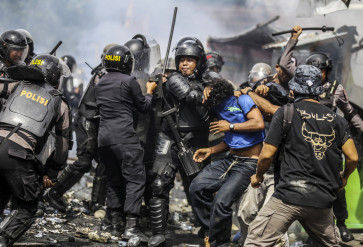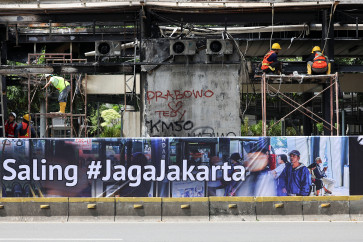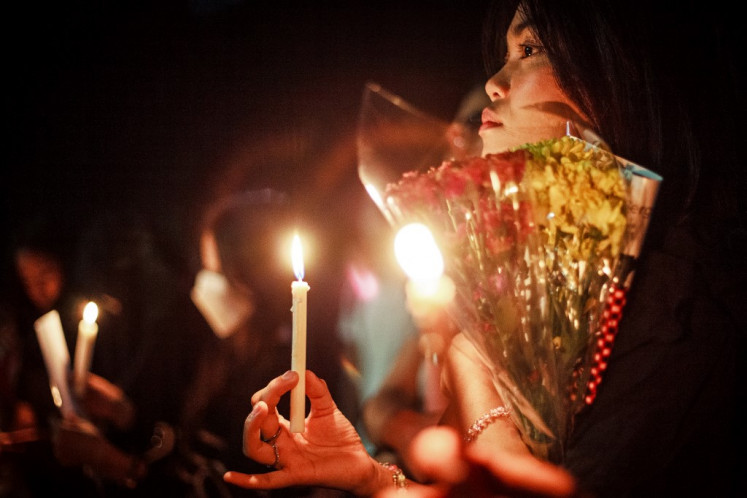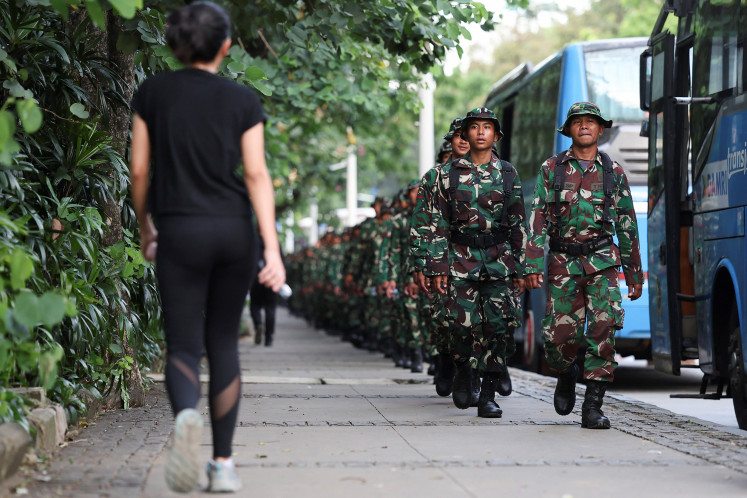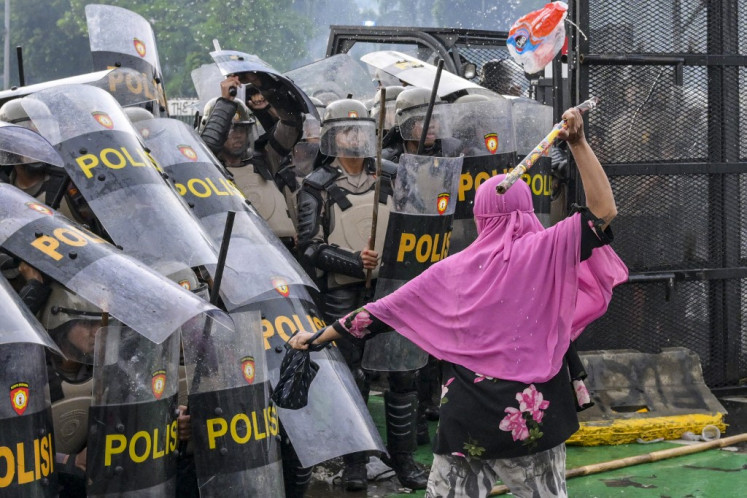Popular Reads
Top Results
Can't find what you're looking for?
View all search resultsPopular Reads
Top Results
Can't find what you're looking for?
View all search results'Rampokan' reinvents the Dutch East Indies
Many comic book lovers have a great attachment to the world-famous Tintin adventures as well as its creator, Hergé, clean and clear-line visual style
Change text size
Gift Premium Articles
to Anyone
Many comic book lovers have a great attachment to the world-famous Tintin adventures as well as its creator, Hergé, clean and clear-line visual style.
It is no wonder then that when Rampokan, a graphic novel series, was published with a strong visual resemblance to Tintin but with an Indonesian setting, it easily found its way to a cult following.
The graphic novel, Rampokan: Jawa, by Dutch comic artist Peter Van Dongen, was first translated into Indonesian back in 2005.
Its original Dutch-language version Rampokan: Java was first published in 1998 and, six years later, Van Dongen created its sequel, Rampokan: Selebes, the last in the series.
In August this year, publisher Gramedia Pustaka Utama translated Celebes and published the two books in one ' Rampokan Jawa & Selebes.
During launch events held in Jakarta and Yogyakarta, Van Dongen was warmly greeted by local comic communities, many of whom were fans of the Rampokan series and Van Dongen's other work.
Many of the fans, some young comic artists, were fascinated by Rampokan's Tintin-esque visual style and accurate, detailed recreation of the two main settings of the story ' old Batavia (now Jakarta) and Celebes (now Makassar in South Sulawesi).
Van Dongen revealed he was largely inspired by the Tintin comics for his visuals, especially The Blue Lotus adventure.

However, he took plenty of freedom in developing the ligne-claire (clear line) style in his own way, supervised by the renowned founder of the genre itself, Joost Swarte, who helped in publishing the first Rampokan: Java.
When starting the book, Van Dongen said he did intensive library and archival research on the Dutch East Indies history and made several trips to Indonesia in the mid-1990s, which also helped him later on in creating Celebes.
The result, visually, is admirable.
In the book, Indonesian readers, as well as those familiar with Indonesia, can easily relate to the stories, from the depictions of people at a Bandung traditional market, to street barbers, vintage Chinese-Indonesian restaurants, old Batavia stations, the Societet building or the old port of Makassar.
Reading through the story and learning more about Van Dongen's background in creating Rampokan is no less intriguing. In fact, it goes beyond aesthetics and a mere sense of nostalgia.
The story of Rampokan was actually created from Van Dongen's attempt to reinvent the Dutch East Indies in his own way, initially from his own family history.
His mother was born in Manado, North Sulawesi, in the 1940s ' the daughter of an Indonesian mother who had heritage from China and Ambon, Maluku, and a Dutch soldier father who was beheaded by the Japanese army during wartime.
As a child, Van Dongen knew about the history of the East Indies only from family stories, since he could not find the information at school. His school only taught European-focused history ' none from the Dutch colonial times in the East Indies.
His curiosity led him to conduct his own personal studies through archives and libraries. He also took trips to Indonesia, a kind of pilgrimage in tracing back his family history, where he managed to meet some of his remaining relatives in Sulawesi.
He then recreated and put together these recollections of memories, experiences and information, transforming them into narrative elements and characters in Rampokan.
The story of Rampokan itself is far from the colorful, humorous, child-friendly adventures of Tintin ' suited more to grown-ups or young adult readers.
It is a dark, complex, period piece told through a multi-layered plot with morally ambiguous characters and hints of violence that are more reminiscent of Alan Moore and Frank Miller's graphic novels than Hergé's work.
The duotone coloring, initially chosen due to budget reasons, further adds to the noir feeling.
The main character is Johan Knevel ' a young volunteer of the Dutch military forces that were sent to Indonesia in 1946 after the Proclamation of Independence to retain Dutch colonies.
Unbeknownst to his compatriots, Knevel's sole reason for joining the army is simply to return to Indonesia, particularly Makassar, which he regards as his homeland, the place where he was born to a Dutch officer's family and spent most of his childhood.
His parents are dead but he wants to find Ninih, an Indonesian woman who was his family's maid, who he loved dearly as a surrogate mother.
On the military ship sailing to Indonesia, Knevel accidentally kills a shipmate, Erik Verhagen, a communist who was actually linked to a rebel movement against the Dutch government in Java and Celebes.
The death of Verhagen haunts Knevel throughout the story, especially when he discovers that Verhagen was a fellow Indies-born, with opposing views about colonialism and the war, making Verhagen a sort of alter-ego character that appears in Knevel's hallucinations and dreams, where he often converses with Verhagen and himself about his own quest.
Knevel's journey is made more complicated by his interactions with other supporting characters ' such as Westerling-like Chris Jonker, a Dutch soldier who is adamant about finishing the guerilla fighters; and Lisa Manggar, a Chinese-Ambon maid and mistress of Jonker's superior Antonie Van Daalen, who gets caught up in the affairs between the three Dutch men.
Another important subplot is one that involves a Dutch deserter, Burt Dekker, who is disguised as a journalist using the alias of Bennie Ribeek. He is connected to a guerilla movement led by local intellectual Amat.
A series of incidents leads Knevel to desert the army and join Amat and Ribeek to return to Makassar, which is elaborated on greatly in Rampokan: Celebes.
Albeit a bit underwritten and serving more as a plot device, the Riebeek and Amat plot reflects plenty of social-political issues from the Dutch East Indies era, which still resonate in present-day Indonesia.
The book highlights conflicts of ideologies and interests among the Dutch and local independence fighters, tensions between Chinese trade communities with Javanese and Buginese, as well as the relationship with the struggle for independence.
The title Rampokan itself is taken from an obsolete Javanese tradition of Rampogan/Rampokan ' a matador-like ritual that involves a troop of warriors with spears fighting tigers, a symbol of taking away evil spirits.
The depictions of Rampokan appear occasionally as flashbacks in the graphic novel, overlapping with the present situations in a multi-layered narrative style.
It also serves as a metaphor for the struggle of local fighters trying to evict the Dutch colonialists from their land.
However, there is a strong hint of irony in the way Van Dongen narrates the metaphor, especially the fate of the animals as not plainly 'evil spirits' but also as victims of sacrifice, somehow reflecting the fate of 'Indo' figures like Verhagen and Knevel.
And yet, somehow it also correlates with the fact that there are no obvious heroes or villains in the story ' as all of the characters are depicted with flaws and become casualties of the war, entangled in its conflicts while trying to uphold their own personal causes.
The graphic novel makes a refreshing addition to the small collection of literary works taking on the colonial and independence-era wartime setting in Indonesia from a contemporary perspective.
It is hoped the book can inspire the new generation of local comic artists, not merely by adapting its visual techniques or style, but by using the method of combining historical research and recollecting personal history as an example, to create stories that offer creative, in-depth ways of retelling our past and its relationship to the present.
Rampokan: Jawa & Selebes
By Peter Van Dongen
Gramedia Pustaka Utama, 2014
168 pages
- Photos courtesy of Gramedia Pustaka Utama


